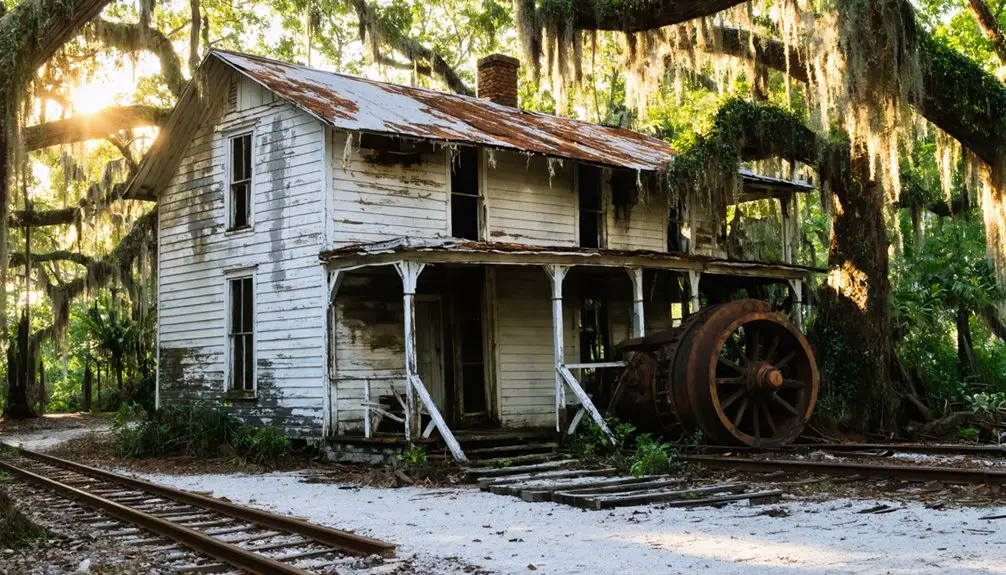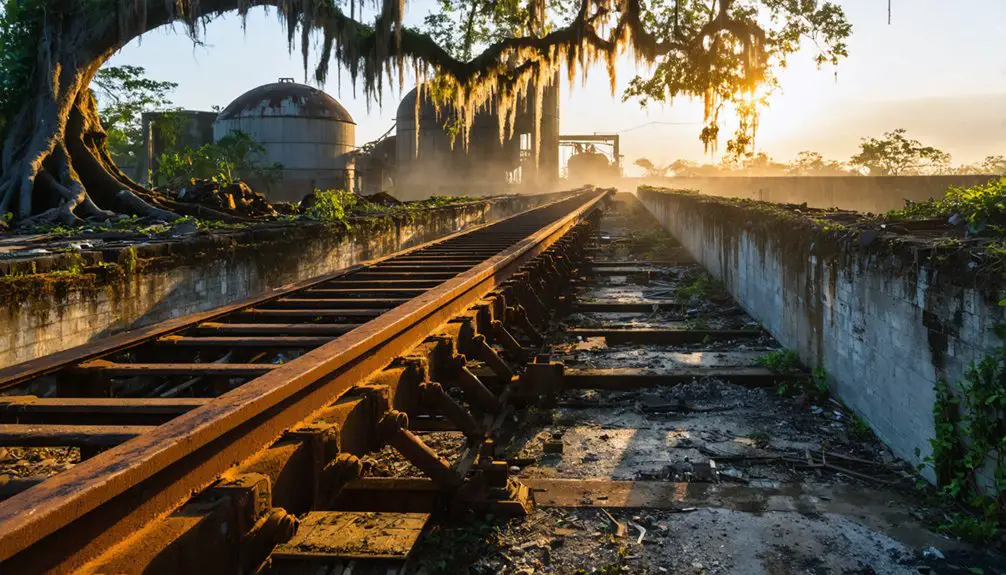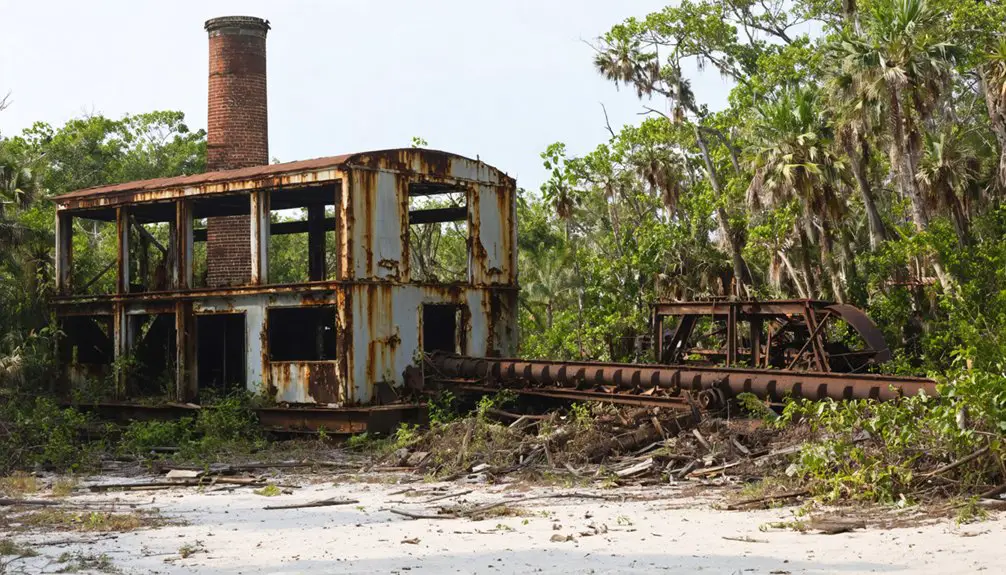You’ll find Pembroke’s industrial story in Florida’s heartland, where it evolved from a Seminole trading post in the 1880s to a booming railroad hub. The town’s peak came in the 1920s through turpentine production and lumber mills, employing over 1,500 workers. Natural disasters, including the Great Freeze of 1894-95, challenged the community’s resilience. While the town declined by mid-century, its legacy of mobile home communities and warehouse districts reveals deeper industrial roots.
Key Takeaways
- Pembroke’s decline began after the 1925 collapse of turpentine production, marking the start of its transformation into a ghost town.
- The Big Freeze of 1894-95 severely damaged local agriculture and initiated the first wave of population decline.
- Railroad operations diminished significantly by the early 1900s, leading to reduced economic activity and population exodus.
- Natural disasters between 1890-1910 damaged crucial infrastructure, contributing to the town’s eventual abandonment.
- The shift from water-powered to steam operations at Clapp Rubber Works represented the last major industrial presence before decline.
Origins and Early Settlement
The indigenous Seminole people first inhabited the southeastern Florida terrain that would later become Pembroke, establishing their presence among the natural wetlands, pine flatwoods, and scrub habitats.
Amid wetlands and pine forests, Seminole tribes made their first home in the untamed wilderness of future Pembroke.
Through settler interactions in the late 19th century, these native communities traded food and tools with newcomers while sharing their knowledge of cleared lands suitable for homesteading.
You’ll find the earliest non-indigenous settlers were drawn to the area’s fertile soil patches and abundant water sources, establishing small family farms and ranches focused on citrus cultivation and staple crops. The devastating great freezes of 1894 severely impacted the local farming operations.
Located near important transportation routes and early railroads, these pioneering homesteads formed tight-knit communities that served as trading posts.
The foundation of early Pembroke emerged from these agricultural roots, with its economy centered on farming, logging, and limestone extraction. The area was originally known as Holly Hill before its incorporation as a town in 1957.
Industrial Boom and Economic Peak
You’d find Pembroke’s industrial fortunes closely tied to the arrival of major railroad expansions in the early 1900s, particularly when the Florida East Coast Railway doubled its tracks through the region.
Like today’s mega-site development, the region’s strategic location and transportation infrastructure played a crucial role in attracting major industrial operations.
By 1920, the town’s strategic rail connections helped establish Pembroke as a significant turpentine production hub, with multiple processing facilities operating at full capacity.
The peak years of turpentine production lasted until 1925, when you’d see workers extracting pine sap from thousands of acres of local pine forests to meet the growing national demand for naval stores and industrial products.
Railroad-Driven Growth Era
During Florida’s transformative railroad era of the 1880s-1920s, Pembroke emerged as a strategic industrial hub, capitalizing on the state’s expanding rail network that had grown to nearly 6,000 miles of track.
You’d find the town thriving at the intersection of railroad innovation and economic diversification, as it leveraged its rail connections to establish profitable manufacturing and processing facilities. Like many emerging rail towns of the era, Pembroke’s development paralleled the success of Florida East Coast Industries, which would later revolutionize private passenger rail service in the state.
Like other railroad towns across Florida, Pembroke’s growth reflected the broader industrial revolution sweeping the state. The town’s success mirrored the Industrial Revolution’s impact on transforming Florida from an underdeveloped region into a thriving economic center.
You could witness the bustling freight yards, lumber mills, and manufacturing facilities that sprang up around the rail depot.
The town’s strategic location allowed it to tap into the vast transportation network that railroad barons like Chipley, Plant, and Flagler had created, connecting it to major markets and fostering unprecedented economic opportunities.
Peak Turpentine Production Years
At its industrial zenith from the late 1800s through the 1920s, Pembroke’s turpentine operations flourished as part of Florida’s booming naval stores industry.
You’d find workers using evolving turpentine extraction methods, shifting from primitive box-cutting to more efficient Herty cup systems that improved both yield and pine tree preservation. The leased convict laborers formed a significant portion of the workforce in these operations.
During peak production, the town’s stills processed 50-gallon barrels of pine resin, each yielding approximately 75 gallons of turpentine spirits. Similar to modern demand for petroleum, turpentine was crucial for solvents, disinfectants, and medicines during this period.
Labor conditions reflected the harsh reality of the era – workers endured dangerous tasks while being paid in company scrip, often trapped in cycles of debt at the camp store.
Despite these challenges, Pembroke’s turpentine production contributed considerably to Florida’s maritime economy, remaining essential until petroleum-based alternatives emerged after World War II.
Railroad Development and Trade Routes
You’ll find Pembroke’s railroad story began in the 1880s when crews laid tracks using locally sourced pine timber sleepers and iron rails shipped from northern foundries.
By 1890, Pembroke had transformed into a bustling transportation hub where agricultural freight from surrounding farms connected to major shipping routes through central Florida. The railroad’s presence attracted young black laborers who migrated from other Southern states seeking employment opportunities in the region.
Your ancestors watched as the town’s initial simple rail depot evolved into an intricate network of switches and sidings that enabled efficient movement of phosphate, lumber, and citrus crops by 1900. The line was originally developed as part of the Florida Southern Railway, which played a crucial role in connecting the region’s agricultural communities.
Early Rail Construction Methods
Early railroad construction relied heavily on wooden rails mounted atop transverse wooden sleepers, marking the humble beginnings of America’s rail infrastructure in the early 1800s.
You’d find these primitive rail lines using strap-iron rails – metal strips nailed to wooden stringers – though they’d often come loose and create dangerous “snake heads” that could pierce train floors.
As rail construction methods evolved, you’d see wrought iron replacing cast iron around 1820, featuring projecting ears for better wood fixing.
While more durable, these tracks still needed frequent maintenance and typically lasted less than a decade.
Track beds weren’t much more advanced than old mine tramways, and you’d encounter single tracks with limited turnouts.
At steep grades, they’d use rope inclines since early locomotives couldn’t handle significant slopes effectively.
The first major improvement came when cast iron strips were laid over wooden rails in 1738, providing better durability for the growing railway network.
Freight Shipping Network Growth
Railroad development in Florida underwent dramatic expansion after 1912, when the Florida East Coast Railway completed its ambitious Jacksonville to Key West line, revolutionizing freight shipping along the Atlantic seaboard. This transformation created crucial rail connections between major ports like Fernandina and Cedar Key, enabling your community’s goods to reach national markets efficiently.
You’ll find that freight logistics improved dramatically as new routes connected the Panhandle’s lumber operations and farming regions to northern markets. The system’s growth helped agricultural communities prosper, particularly in areas producing citrus and timber.
Private investors like Henry Flagler and Henry Plant drove this expansion, establishing essential infrastructure that included land development companies and industrial zones. Their strategic investments created an integrated network that would forever change how Florida’s communities conducted trade and commerce.
Transportation Hub Connections
As Florida’s freight network expanded, the development of strategic transportation hubs became central to Pembroke’s industrial evolution.
You’ll find that pivotal rail connections, established by pioneers like David Levy Yulee’s Florida Railroad in 1860, created essential cross-state corridors linking Fernandina to Cedar Key, revolutionizing freight logistics throughout the region.
The town’s position within these transportation networks proved advantageous as railroad magnates Henry Plant and Henry Flagler extended their lines through central and southern Florida.
Their developments transformed Pembroke’s accessibility, connecting you to both east and west coast ports while establishing vital infrastructure for industrial growth.
The addition of rail sidings, stocking yards, and connecting spurs empowered local manufacturers to efficiently move raw materials and finished goods across the state.
Life in a Florida Mill Town

The bustling mill town of Pembroke emerged as a significant industrial hub by the late 1880s, when its mills employed between 75 and 100 local workers.
You’d find yourself living in a close-knit community where daily life revolved around factory shifts and the rhythmic hum of machinery.
By 1900, you’d witness the town’s dramatic transformation as over 1,500 workers, many from Quebec, shaped the community dynamics through their cultural integration.
Your life would center around the mill’s schedule, with housing typically provided by mill owners.
You’d work long hours, especially after the 1879 switch to steam power enabled 24-hour operations.
The local commercial district, built from granite and brick, would serve your daily needs, though social mobility remained limited in this industrial-dependent community.
Natural Disasters and Economic Challenges
While natural disasters routinely challenged Florida’s coastal towns, Pembroke faced particularly devastating blows between 1890-1910. The town’s economic vulnerabilities became apparent as hurricanes repeatedly damaged its critical infrastructure, including the sawmill and railroad connections that were its lifeline.
You’d have seen how these natural disasters compounded the community’s existing challenges, from dwindling timber resources to increasing competition from larger industrial centers.
The devastating Big Freeze of 1894-95 struck a severe blow to nearby agricultural operations, further weakening Pembroke’s economic foundation.
When storms destroyed transportation routes and production facilities, the town couldn’t afford repairs. Workers began leaving for more stable opportunities elsewhere, and without adequate funding to maintain essential services, Pembroke’s industrial operations gradually ground to a halt.
Legacy of Pembroke’s Industrial Past

From its humble beginnings in 1873, Pembroke’s industrial legacy started with Clapp Rubber Works, marking a distinct shift from the town’s struggles with natural disasters.
You’ll find that this pioneering facility transformed from water-powered operations to steam power, eventually commanding over half of America’s rubber processing market.
The town’s industrial heritage evolved through distinct phases, from Clapp’s dominance to the controversial Petroleum Products Corporation era of the 1950s-70s.
You can trace Pembroke’s economic transformation through the rise of warehouse districts near major highways, which attracted over 600 businesses by the early 2000s.
This industrial growth shaped the community’s character, spurring the development of mobile home parks and creating a working-class identity that’s still visible in the area’s 17 mobile home communities today.
Historical Sites and Remnants Today
Since Pembroke’s gradual decline in the late 20th century, you’ll find its most tangible historical remnants in the area’s cemeteries and scattered structural artifacts.
The Giddens Homestead Cemetery stands as one of the region’s oldest burial grounds, where wooden markers and weathered headstones tell stories of early settler life.
As you explore the overgrown landscape, you’ll discover brick foundations, metal structures, and remnants of logging roads that once supported the town’s industrial activities.
Cemetery preservation efforts by local historians maintain these vital historical markers, while natural reclamation has protected many artifact recovery sites from development.
You can still spot “catface” scars on old trees and Herty cups, silent witnesses to Pembroke’s turpentine industry.
Though some sites are only accessible by hiking trails, they’re carefully documented through historical markers and local preservation initiatives.
Frequently Asked Questions
What Happened to the Families Who Lived in Pembroke After Abandonment?
You’ll find these families adapted through strategic relocation to nearby towns, where they’d shift from industrial work to citrus farming or turpentine production, maintaining their social networks despite economic impact.
Were There Any Significant Crimes or Lawlessness During Pembroke’s Industrial Period?
Like a blank page in history’s book, you won’t find records of significant crime rates or lawlessness. While the town had its share of struggles, there’s no evidence of major law enforcement issues.
Did Native American Communities Interact With Pembroke’s Industrial Operations?
You’ll find evidence of cultural exchange between Native Americans and Pembroke’s workers, with local Seminoles adapting their economic activities through craft sales and occasional labor while maintaining their traditional community ties.
What Was the Average Wage for Workers in Pembroke’s Mills?
You’d find mill workers earned around 37 cents per hour in 1919, which was double earlier rates. Today’s equivalent workers make between $9.00-$18.86 hourly, averaging $13.70 in Florida’s mills.
Did Any Famous Historical Figures Visit or Have Connections to Pembroke?
Like many small industrial towns lost to time, you won’t find records of famous historical visits or notable connections to Pembroke. Local settlers and Seminole traders formed the heart of its humble community.
References
- https://www.youtube.com/watch?v=lKufguzO19k
- https://cccourthouse.org/wp-content/uploads/2023/12/Ghost-towns-and-Cemeteries-of-Citrus-County.pdf
- https://www.thetravel.com/skip-bodie-for-abandoned-ghost-towns-in-florida/
- https://floridatrailblazer.com/2017/06/21/markham-ghost-town-in-seminole-county/
- https://www.youtube.com/watch?v=674cMcVWCIk
- https://www.youtube.com/watch?v=qORyGmeG7HM
- https://www.clickorlando.com/news/local/2025/03/06/exploring-the-ghost-town-of-markham-in-seminole-county/
- https://digitalcommons.fiu.edu/cgi/viewcontent.cgi?article=1019&context=mpo_broward
- https://www.freakyfoottours.com/us/florida/
- https://www.broward.org/History/pages/bchistory.aspx



